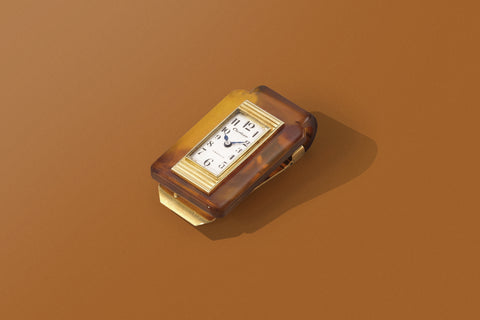The Case
The distinguishing feature of this clock is its capacity to open and close to reveal the clock face. When opened, the cover doubles up as a stand, allowing the dial to be displayed, and when closed, the cover protects the face from potential damage.
The dark tan, snakeskin-like texture of the case provides a contrast to the ivory face, with the appearance catching and reflecting light attractively.
The Dial
The dial itself is well preserved, featuring a rectangular minute track that runs around the centre of the dial. The dial and hands have developed an even, satisfying patina over time, consistent with clocks from the period. The numerals are rendered in a stylised font that characterises the Art Deco movement. These are outlined in black, with each numeral bearing a slant that gives visual depth and a sense of playfulness to the design. The cathedral-style hands are a similar ivory shade to the dial, and are also outlined in black.

illustration by Prints Harry X A Collected Man
Intriguingly, this clock marks a time before Jaeger merged with LeCoultre to form the brand we know today, as evidenced by the small signature just above the 12 o’clock numeral – similar clocks from the period can usually be found with a full or partial “Jaeger-LeCoultre” signature, which is given a more prominent place near the centre of the dial.
The Movement
The clock also features an 8-day power reserve, indicated by the “EIGHT DAYS” printed just above the six o’clock numeral, a marked improvement from previous clocks of the 1920s, which only had 2-day power reserves.
The mechanism can be manually wound through the crown at twelve o'clock. It has recently been fully serviced, and comes with a one-year warranty from A Collected Man.
If sold within the United Kingdom, this Jaeger travel clock will be subject to 20% VAT.








































































































































































































